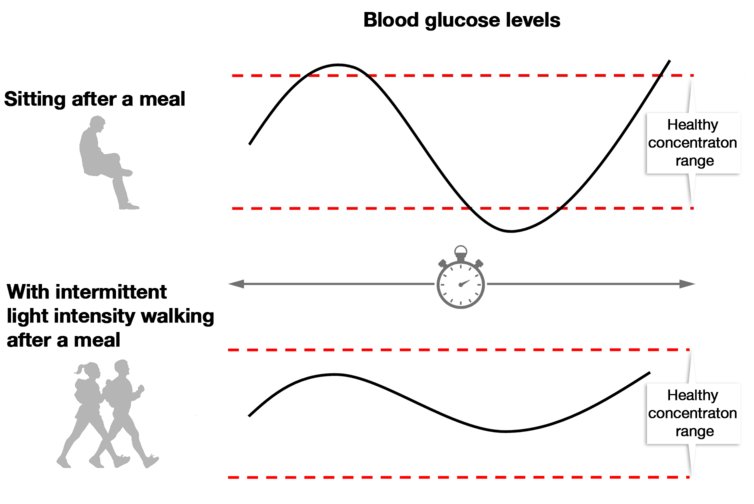The problem with too much sitting
Too much sitting can increase the risk of early death. It’s estimated that 60-75 minutes a day of moderate to vigorous intensity exercise is required to offset the increased risk of death associated with more than eight hours a day of sitting.
This is a lot of exercise. At least twice as much as the current minimum recommended amount for adults. So reducing sitting may be an additional health-enhancing strategy.
Multiple studies have demonstrated that reducing and replacing sitting with light intensity walking improves glucose control after food consumption. That means glucose levels that do not spike too high, or dip too low. This may be explained by the way working muscles can use up some of the glucose in our system, helping to keep glucose in the optimal range.

Evidence suggests that when it comes to glucose control, light intensity physical activity spread across the day can be superior to a day in which a single bout of moderate to vigorous exercise is performed in the morning. Even when the total energy expenditure of the light intensity activity is equal to the energy expenditure of the single bout of higher intensity activity.
Improved glucose control may explain some of the health benefits of reducing sitting time, but what about effects on brain function?
https://www.weforum.org/agenda/2017...al&utm_source=twitter.com&utm_campaign=buffer
Too much sitting can increase the risk of early death. It’s estimated that 60-75 minutes a day of moderate to vigorous intensity exercise is required to offset the increased risk of death associated with more than eight hours a day of sitting.
This is a lot of exercise. At least twice as much as the current minimum recommended amount for adults. So reducing sitting may be an additional health-enhancing strategy.
Multiple studies have demonstrated that reducing and replacing sitting with light intensity walking improves glucose control after food consumption. That means glucose levels that do not spike too high, or dip too low. This may be explained by the way working muscles can use up some of the glucose in our system, helping to keep glucose in the optimal range.

Evidence suggests that when it comes to glucose control, light intensity physical activity spread across the day can be superior to a day in which a single bout of moderate to vigorous exercise is performed in the morning. Even when the total energy expenditure of the light intensity activity is equal to the energy expenditure of the single bout of higher intensity activity.
Improved glucose control may explain some of the health benefits of reducing sitting time, but what about effects on brain function?
https://www.weforum.org/agenda/2017...al&utm_source=twitter.com&utm_campaign=buffer
